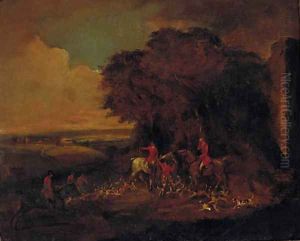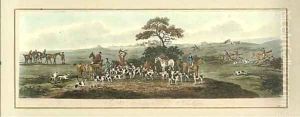Dean Snr Wolstenholme Paintings
Dean Wolstenholme the Elder, born in 1757 and died in 1837, was a renowned British artist, primarily celebrated for his detailed and vivid depictions of sporting scenes, particularly those involving hunting and animals. His work is characterized by its meticulous attention to detail and its ability to capture the dynamic nature of rural and sporting life in the 18th and early 19th centuries. Wolstenholme's contributions to British art are often associated with the tradition of animal painting and sporting art that was increasingly popular during his lifetime.
Wolstenholme was born into a time of significant social and artistic change. The son of a cloth worker, he initially pursued a career outside of art, but his passion and talent for painting soon became apparent. He was largely self-taught, which was not uncommon for the time, and he managed to carve out a successful career as an artist despite the lack of formal artistic training. His work gained popularity for its authenticity and the way it resonated with the British public's growing interest in nature, rural life, and sports, particularly fox hunting.
Throughout his career, Wolstenholme exhibited at prestigious institutions, including the Royal Academy, although he was never a member. His paintings were sought after by the gentry and the aristocracy, who were keen to commission works that reflected their leisure pursuits. Wolstenholme's ability to depict animals with accuracy and empathy, combined with his skill in rendering the British landscape, won him acclaim and respect among his contemporaries.
Wolstenholme's legacy was carried on by his son, Dean Wolstenholme the Younger, who also became a respected artist in the same genre. Together, they represent a significant chapter in the history of British sporting and animal art. The elder Wolstenholme's work provides a fascinating window into the social and cultural interests of the Georgian and early Victorian eras, capturing the essence of an age with elegance and historical value. Today, his paintings are held in high regard, with many featured in art collections, museums, and galleries around the world, offering ongoing inspiration and appreciation for lovers of British art and history.

